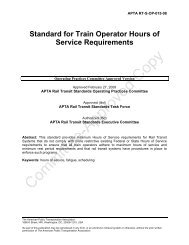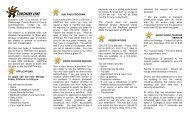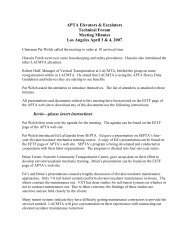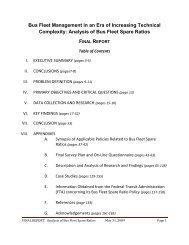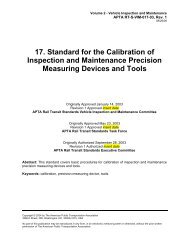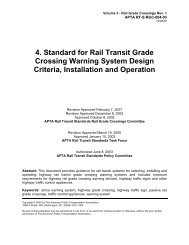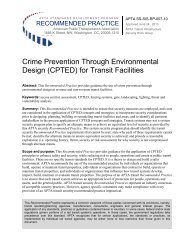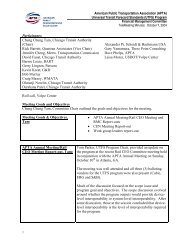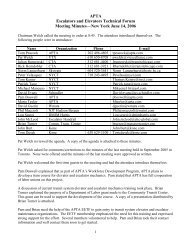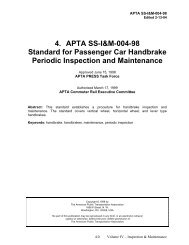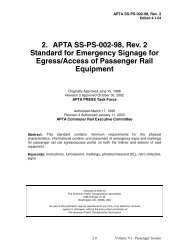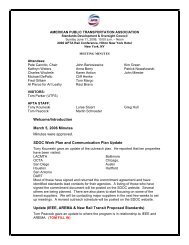Standard Bus Procurement Guidelines - APTAStandards.com
Standard Bus Procurement Guidelines - APTAStandards.com
Standard Bus Procurement Guidelines - APTAStandards.com
Create successful ePaper yourself
Turn your PDF publications into a flip-book with our unique Google optimized e-Paper software.
<strong>Standard</strong> <strong>Bus</strong> <strong>Procurement</strong> <strong>Guidelines</strong><br />
Baseline: No requirement for a retarderactivated<br />
cooling fan.<br />
5.2.2.1.5 Jerk<br />
percent of its capability when the brake pedal<br />
is depressed and the throttle <strong>com</strong>pletely<br />
released.<br />
Alternative: Retarder-activated cooling fan.<br />
The thermostatically controlled cooling fan<br />
shall be activated when the retarder is<br />
engaged and the coolant temperature above<br />
exceeds the minimum limit established by the<br />
engine and transmission manufacturers.<br />
Jerk, the rate of change of acceleration measured at the centerline, floor level of the bus shall be<br />
minimized throughout the shifting of each transmission range and retarder application and shall be no<br />
greater than 0.3 g/sec. for a duration of a quarter-second or more. This requirement shall be achieved<br />
regardless of driver actions.<br />
5.2.2.2 Mounting<br />
The power plant shall be mounted in a <strong>com</strong>partment in the rear of the bus. All power plant mounting<br />
shall be mechanically isolated to minimize transfer of vibration to the body structure as defined in<br />
section 5.4.1.5. Mounts shall control movement of the power plant so as not to affect performance of<br />
belt driven accessories or cause strain in piping and wiring connections to the power plant.<br />
5.2.2.2.1 Service<br />
The power plant shall be arranged so that accessibility for all routine maintenance is assured. No special<br />
tools, other than dollies and hoists, shall be required to remove the power plant. Two 3M mechanics<br />
shall be able to remove and replace the engine and transmission assembly in less than 8 total <strong>com</strong>bined<br />
man-hours. The muffler, exhaust system, air cleaner, air <strong>com</strong>pressor, starter, alternator, radiator, all<br />
accessories, and any other <strong>com</strong>ponent requiring service or replacement shall be easily removable and<br />
independent of the engine and transmission removal. An engine oil pressure gauge and coolant<br />
temperature gauge shall be provided in the engine <strong>com</strong>partment. These gauges shall be easily read<br />
during service and mounted in an area where they shall not be damaged during minor or major repairs.<br />
Engine oil and the radiator filler caps shall be hinged to the filler neck and closed with spring pressure or<br />
positive locks. All fluid fill locations shall be properly labeled to help ensure correct fluid is added and<br />
all fillers shall be easily accessible with standard funnels, pour spouts, and automatic dispensing<br />
equipment. All lubricant sumps shall be fitted with magnetic-type, external, hex head, drain plugs.<br />
The engine and transmission shall be equipped with sufficient heavy-duty fuel and oil filters for efficient<br />
operation and to protect the engine and transmission between scheduled filter changes. To the extent<br />
practicable, the filters shall be of the spin-on, disposable type or integral with the engine and<br />
transmission. All filters shall be easily accessible and the filter bases shall be plumbed to assure correct<br />
Technical Specifications 138 10/18/07



